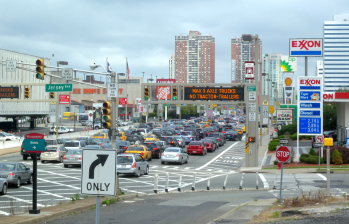Infrastructure Bigs: To Compete, NYC Needs Congestion Pricing, Tolls
 Tolls at the Holland Tunnel. Now the Port Authority is looking for the next financing model. Image: Library of Congress.
Tolls at the Holland Tunnel. Now the Port Authority is looking for the next financing model. Image: Library of Congress. At a panel put on by the New School last week, some of New York’s biggest players in transportation and planning came together to discuss the future of the city’s infrastructure. They all seemed to agree: The city can’t keep up with its global competitors without new sources of revenue.
Christopher Ward, the executive director of the Port Authority, framed the stakes: "We have to ask, what builds wealth?" The other panelists concurred: New York’s health and economic dominance won’t continue without consistent investment in its infrastructure, particularly its transportation network.
Seth Pinsky, the president of the New York City Economic Development Corporation, put it more directly. "We have spent the last 20 years trying to get our infrastructure back to pre-1970 levels," he said. Without moving further, "We will not be able to compete with other world cities."
The challenge, though, is financing. Especially if you’re talking about the panel members’ top priorities: The ARC tunnel, the 41st Street station on the 7 line subway extension, renovation of the Delta Terminal at JFK, and the East Side Access project are exceedingly expensive. Ward stated that the Port Authority’s current commitments mean that no new capital projects are on the table for the next decade, even though his agency is among the more fiscally healthy in the region.
Ward identified two different causes of the infrastructure funding crunch. The first is that "we are living in the out years," experiencing a budget crisis deferred from a generation earlier. Additionally, he said, "we’re largely ignoring the role of urban centers because of this idea that you can do more with less," which he traced back to the Reagan Administration.
Kathryn Wylde, the president of the Partnership for New York City, underscored the sense of fiscal crisis. "Even what we have, we don’t have," she said, referring to the recent attempt by Westchester legislators to cut the payroll tax from last summer’s MTA rescue package.
The solution, they all seemed to agree, will necessarily include new funding mechanisms. Ward claimed that "the congestion pricing initiative will return time and time again until we get it right." Robert Yaro, the president of Regional Plan Association, agreed: "Congestion pricing is going to be back."
Higher tolls were repeatedly discussed approvingly, though no one got into specifics.
The panel also showed a lot of interest in raising revenue from increases in real-estate prices where new infrastructure is built, a process known as value capture. Yaro proposed that new transportation infrastructure could be paid for by recapturing some of the "hundreds of thousands of dollars" added "to each home within a half mile of those stations." Pinsky noted that "that’s essentially what we’ve done with the 7 extension," where the process has raised billions. Ward also expressed interest in value capture.
The focus on expensive mega-projects led one panelist to question whether less costly solutions should play a larger role in addressing the region’s transportation needs. Alyssa Katz, a consultant at the Pratt Center for Community Development, introduced Bus Rapid Transit into the discussion, noting that projects the other panelists seemed to favor are "incredibly expensive and difficult to do."
While the other panel members sounded bullish on BRT, they also seemed to downplay its potential significance within the region’s transportation network. "If you look at connectivity," said Ward, "BRT is a good example of that at the local level. But then there’s the regional connectivity and the global connectivity." Similarly, Yaro said that "BRT doesn’t replace; it complements."
